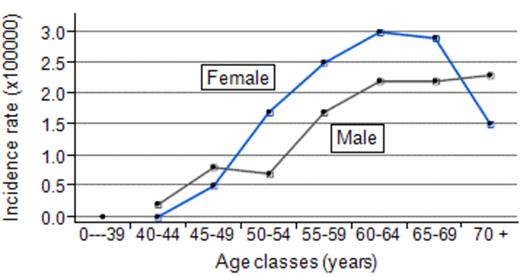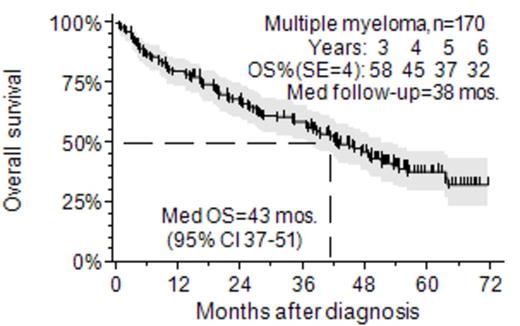Abstract
Background: The greatest progress in treatment of lymphoproliferative malignancy multiple myeloma (MM) was achieved in the past decade. According to population studies, in the last decade 5-year overall survival (OS) rate in patients (pts) with MM in the Germany was 39%, in the USA - 47%.
Aims: To evaluate 5-year OS and progression-free survival (PFS) rates, to reveal the main independent predictor of mortality in pts with MM in Russia.
Patients and Methods: Five medical centers participated in prospective study in Russian Federation. During the period from January 1st, 2009 to January 1st, 2012 170 pts with newly diagnosed MM were included (68 male, 102 female) in the study. The median age was 61 years (range 42 - 86). The primary endpoint was January 1st, 2015. 111 of pts (65%) were younger 65 years. At the moment of diagnosis most pts (25%) were in age between 55 and 60 years. The largest incidence rate for both sexes was in age between 60 and 65 years (Figure 1). Distribution of disease stages according to the Durie Salmon system was the following: III stage - 50%, II stage - 45%, I stage - only 5%. The most pts (55%) were with myeloma G. 83% of pts received bortezomib-based first line treatment, 16% of pts received only chemotherapeutic drugs; refusal of treatment was registered in 1% of cases. Autologous transplantation was performed in 14 (13%) patients in the age under 65 years. Overall response was achieved in 68% of pts, complete remission - in 26%.
OS and PFS were evaluated using Kaplan-Meier analysis. Time to OS and PFS (events: progression or death) were measured from the initiation of treatment. Multivariate Cox proportional hazards regression analysis (after univariate analysis) was used to identify the main independent predictor of death. Statistical analysis was performed with SAS v.9.1.
Results: 5-year OS rate was 37%, 5-year PFS - 16%, the median follow-up was 38 months (Figure 2 and 3). According to multivariate analysis the main factor associated with mortality was the stage of disease. For the I stage 5-year OS was 100%, for the II stage - 36%, for the III stage - 25% (the pairwise differences between OS was statistically significant, ð<0.05).
Conclusion: Our study revealed that the median age in a study pts with MM is ten years less than in Europe and USA. Main independent predictor of OS rate is the stage of disease.
Multiple myeloma crude incidence rates (x 100,000) by age class and gender based on five regions of Russia.
Multiple myeloma crude incidence rates (x 100,000) by age class and gender based on five regions of Russia.
Volodicheva:CELLTRION, Inc.: Research Funding.
Author notes
Asterisk with author names denotes non-ASH members.




This feature is available to Subscribers Only
Sign In or Create an Account Close Modal